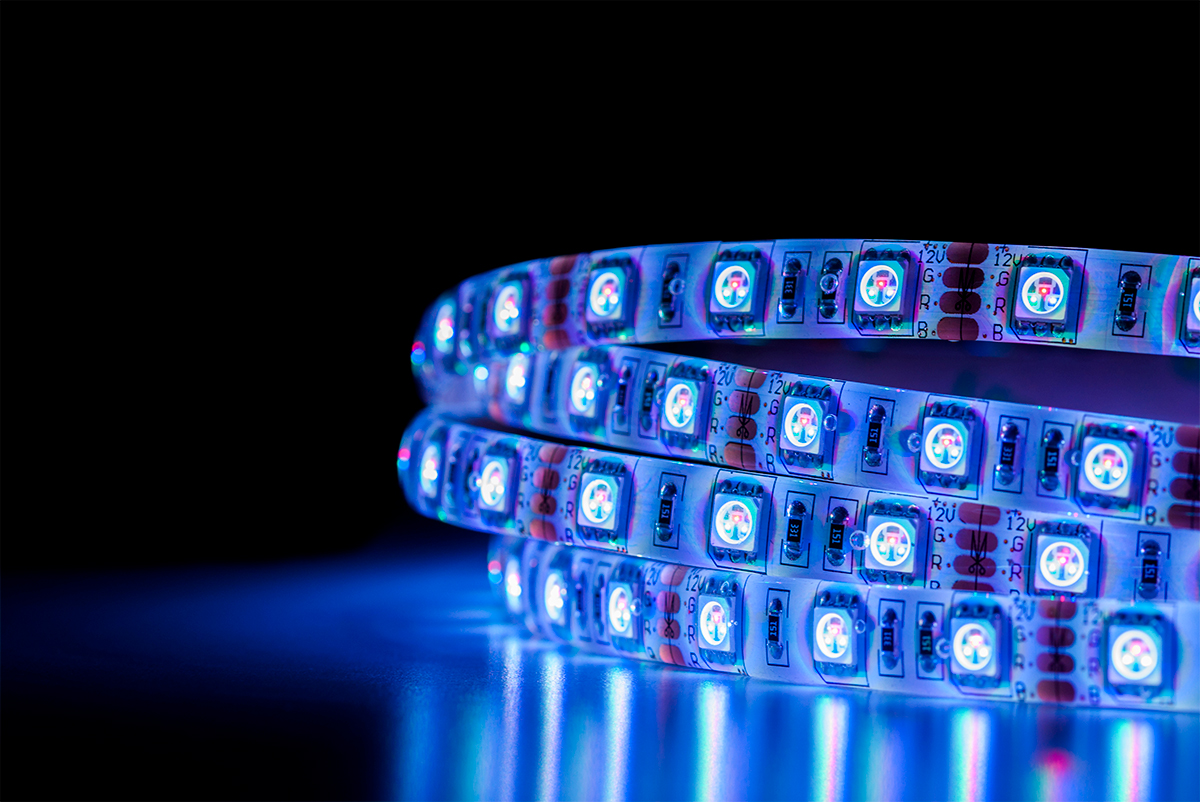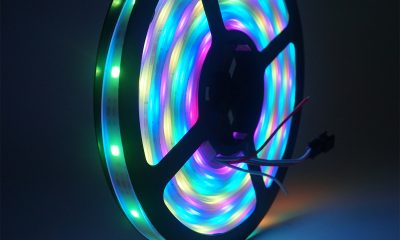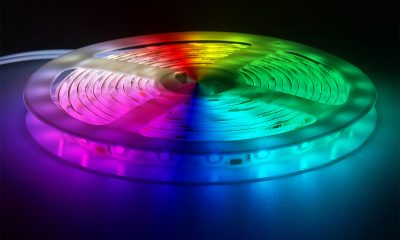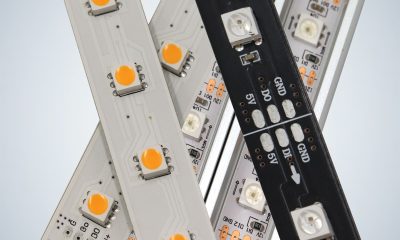What is an individually addressable LED strip light
An individually addressable LED strip light is a digital linear LED array that has the ability to control every single LED, or discrete groups of LEDs, independent of the circuit to which the LEDs are connected. Flexible LED strip lights fall into two types: the “analog” type and “digital” type. Analog LED strips are non-addressable lights that do not offer the ability to assign color or intensity to each LED individually. The LEDs mounted across the entire length of the strip or on the controlled circuit will respond to on/off switching or dimming control signals in the same fashion. You can change the color or intensity anytime you want for the whole analog strip, but can’t change it for an individual LED or a section of LEDs. A digital LED strip is mounted with individually addressable LEDs that allow the strip to deliver different colors and/or different brightnesses on multiple LEDs simultaneously.
Addressable LEDs
Digital LED strip lights are commonly designed as RGB, RGBW or other multi-color systems, although tunable white, solid white or single color LED strips are available as well. The digital controllability of the strip lights is delivered by addressable LEDs which incorporate onboard circuitry to interpret control signals from a master controller and drive the LEDs in accordance with the commands. Addressable LEDs come with the same form factor and size of the analog counterparts (dumb LEDs) that follow the standard nomenclature for SMD LED packages such as 5050, 3535, 2427, 2020, 1515, etc. A dumb SMD LED is a simple plastic leaded chip carrier (PLCC) package that includes one or more LED chips (diodes) mounted on silver (Ag)-coated metal lead frames surrounded by a plastic cavity. The package provides a platform that allows the LED chips to be mechanically, thermally and electrically interfaced to their operating interface. The LED is operated by an external driver which can be designed to dim the LED through pulse-width modulation (PWM) or constant current reduction (CCR). An addressable LED includes all the components that constitute a standard SMD package, but is differentiated with the inclusion of control circuitry that performs the function of an intelligent LED driver.
Multi-channel dimming
An addressable LED is essentially a smart, mini light engine that is driven and operated by an integrated microcontroller or microprocessor (controller IC). The controller IC provides diode-level control, which means each channel of a multi-color or multi-CCT LED package is individually controlled. Diode-level control is a tremendous advantage for RGB, RGBA or RGBW systems because it enables high performance color mixing. An RGB LED, for example, is comprised of three LED chips which emit red, green, and blue respectively. The green and blue LED chips are fabricated using indium gallium nitride (InGaN) chip technology, and the red diode is an aluminum indium gallium phosphide (AlInGaP) chip. However, the AlInGaP-based red LEDs have low external quantum efficiencies and suffer from a higher thermal efficiency droop than InGaN-based green and blue LEDs. To produce predictable colors from an RGB LED, individual and accurate dimming control of each of its component LEDs is critical. The ability to control individual LED chips allows to build a highly accurate multi-channel lighting system with addressable LEDs. Incorporating all component LEDs into a single package lends addressable LED another major advantage of package-level color mixing. Integrated RGB packages do not require color mixing distance, which means the digital RGB LED strip can be placed directly on the application surface.
Package options
There is a huge range of options out there for the controller IC design. Some of these offerings include WS2811, WS2812, WS2812B, WS2815, TM1803, TM1809, SK6812, SK6813, SK9822, SM16704, APA102, APA102C, GS8208, GE8808, GE8812, GE8822, GS8208, SM16703, UCS1903, UCS2904, LPD8806, UCS512A, SM16703, and DMX512. Among these options WS2812B, SK6812, APA102C and SK9822 are the most widely used controller ICs. The WS2812B is a programmable constant current RGB controller that is integrated in an SMD 5050 package. This controller IC uses an NZR data transfer protocol via a specialized one-wire control interface and thus requires very precise timing of data signals. As improved versions of the WS2812B, the WS2813 and WS2815 embrace a dual-signal-wire design that allows signal break-point continuous transmission. The SK6812 is a WS2812B alternative. This controller IC has voltage-independent color and brightness over a wide voltage range, which translates to improved color stability against voltage drops. Other than the standard RGB version, the SK6812 addressable LEDs also have a RGBW version.
Control protocol
In contrast to the WS2812B and SK6812 control ICs that use a one-wire protocol, the APA102C uses a standard Serial to Peripheral Interface (SPI) for control with separate data and clock signals. Operating over a generic 2-wire SPI bus allows the color and brightness of each LED channel to be controlled independently. APA102C LEDs also have much higher PWM refresh rates than the WS2812B and SK6812 LEDs, which make them less prone to flickering when recorded with an HD video camera and lend them to applications like persistence-of-vision (POV) displays. The SK9822 is very similar to the APA102C. It uses an identical LED data 32 bit protocol with a 5-bit global brightness setting. The SK9822 have some additional features, including the non-staggered update, the programmable current source for controlling global brightness, and the ability to provide flicker-free lighting over a wide voltage range. But this type of control ICs does come with a few downsides, which include poor protocol compatibility and the lower PWM frequency.
LED controller
Individually addressable LED strip lights are connected to a compatible controller, where a valid command has to be sent through it to the addressable LEDs. They are often operated over the SPI from embedded computers like Arduino, Raspberry Pi, BeagleBone, SparkCore, and any microcontrollers/microprocessors that have libraries allowing you to communicate with SPI devices. The SPI controllers receive video information from a PC running custom lighting control software, or use Art-Net, live video stream or SD card as the video source. With 24-bit color control (8-bit PWM precision per channel) and individual addressability, digital RGB LED strips can be used to create an infinite variety of dynamic effects and intricate color patterns. SPI LED controllers can be designed to work under RF/WiFi mode for wireless control with RF remotes, or via an app installed on iOS or Android smart phones. Some SPI LED controllers are configured to convert DMX512 digital signals to SPI digital signal, and work on DMX consoles to control the digital LED lights.
Power supply
Most digital LED strips operate on 5V DC electrical power. However, there’re products that work at 12V or 24V DC. Higher voltage power supplies are required when there’s a need to drive higher voltage LEDs (e.g. the 12V WS2815 LEDs), to operate strips with LED strings having multiple LEDs connected in series, or to ensure consistent brightness and color on long run lengths. The SMD LEDs are reflow soldered on a flexible printed circuit board that is fabricated from polyimide polymer and laminated with rolled annealed (RA) copper traces. The LED strip can be cut to any length every LED or string. Multiple digital LED strips can be connected as well.


















Loading...